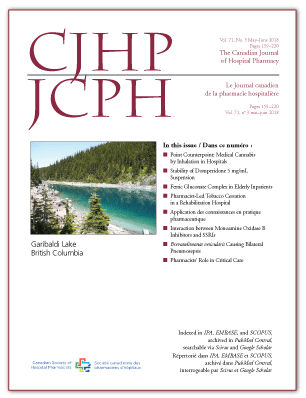Ferric Gluconate Complex in Elderly Hospital Inpatients without Terminal Kidney Failure
DOI:
https://doi.org/10.4212/cjhp.v71i3.2583Keywords:
elderly, iron, iron-deficiency anemia, hospital pharmacy service, patients âgés, fer, anémie ferriprive, service de pharmacie en établissement de santéAbstract
ABSTRACT
Background: Anemia is a common health issue for elderly patients. For patients with iron deficiency who cannot tolerate iron supplementation by the oral route, the parenteral route may be used. Options for parenteral iron supplementation include ferric gluconate complex (FGC).
Objectives: To evaluate the safety of FGC in elderly patients without terminal kidney failure and to assess its efficacy in treating iron-deficiency anemia.
Methods: An observational chart review was conducted at a tertiary care university health centre. Patients included in the study were 65 years of age or older, had received at least 1 dose of FGC between January 1, 2014, and December 31, 2015, and had a hemoglobin count of less than 130 g/L (men) or less than 120 g/L (women) at baseline. For each patient, the observation period began when the first dose of FGC was administered and ended 60 days after the last dose. The main safety outcome (occurrence of any adverse reaction) was evaluated for every patient, with the efficacy analysis being limited to patients with a diagnosis of iron deficiency anemia.
Results: A total of 144 patients were included in the study, of whom 76 had iron-deficiency anemia. No serious, life-threatening adverse reactions were reported. The most commonly reported adverse reactions were nausea and vomiting. The mean increase in hemoglobin count was 13.5 g/L, a statistically significant change from baseline.
Conclusions: These results show that FGC is safe for use in elderly patients, with very few mild adverse reactions. Use of FGC led to increased hemoglobin count within 60 days. Of the 3 options for parenteral iron supplementation available in Canada, iron sucrose has not been studied in elderly patients, and iron dextran has a higher incidence of anaphylaxis, whereas FGC appears to be a safe alternative for patients with intolerance to oral iron.
RÉSUMÉ
Contexte : L’anémie est un problème de santé courant chez les patients âgés. Les patients qui présentent une carence en fer et une intolérance à la prise de suppléments de fer par la voie orale peuvent être traités par voie parentérale. Le complexe de gluconate ferrique de sodium (CGFS) représente l’une des options d’apport complémentaire en fer par voie parentérale.
Objectifs : Évaluer l’innocuité du CGFS chez le patient âgé qui n’est pas atteint d’insuffisance rénale terminale et évaluer son efficacité dans le traitement de l’anémie ferriprive.
Méthodes : Une analyse observationnelle a été menée au moyen des dossiers médicaux dans un établissement de santé universitaire de soins tertiaires. Les patients dont le dossier médical a été retenu pour l’analyse étaient âgés de 65 ans ou plus, avaient reçu au moins une dose de CGFS entre le 1er janvier 2014 et le 31 décembre 2015 et présentaient initialement un taux d’hémoglobine de moins de 130 g/L (hommes) ou de moins de 120 g/L (femmes). Pour chaque patient, la période d’observation s’étendait du moment où la première dose de CGFS avait été administrée au soixantième jour suivant la dernière dose. Le principal paramètre d’évaluation de l’innocuité (survenue de toute reaction indésirable) faisait l’objet d’une évaluation pour chaque patient. L’analyse de l’efficacité se limitait aux patients ayant reçu un diagnostic d’anémie ferriprive.
Résultats : Au total, 144 patients ont été admis à l’étude et, parmi eux, 76 présentaient une anémie ferriprive. Aucune réaction indésirable grave menaçant la vie du patient n’a été notée. Les réactions indésirables les plus souvent signalées étaient des nausées et des vomissements. L’augmentation moyenne des taux d’hémoglobine était de 13,5 g/L, un changement statistiquement significatif comparé à la valeur de départ.
Conclusions : Les résultats montrent que le CGFS est sécuritaire pour le patient âgé et qu’il ne provoque que très peu de réactions indésirables légères. L’emploi du CGFS a produit une augmentation des taux d’hémoglobine en moins de 60 jours. Parmi les 3 options d’apport complémentaire en fer pris par voie parentérale disponibles au Canada, le fer-saccharose n’a pas été étudié auprès de patients âgés et le fer-dextran est associé à une plus grande incidence de cas d’anaphylaxie; or, le CGFS semble être une solution sécuritaire pour les patients qui présentent une intolérance au fer administré par voie orale.
Downloads
Published
Issue
Section
License
Copyright © Canadian Society of Healthcare-Systems Pharmacy.
After publication of a manuscript in the CJHP, the authors of the manuscript must obtain written permission from the CSHP (publications@cshp.ca) before reproducing any text, figures, tables, or illustrations from the work in future works of their own. If a submitted manuscript is declined for publication in the CJHP, all said rights shall revert to the authors. Please note that any forms (e.g., preprinted orders and patient intake forms) used by a specific hospital or other health care facility and included as illustrative material with a manuscript are exempt from this copyright transfer. The CJHP will require a letter from the hospital or health care facility granting permission to publish the document(s).










